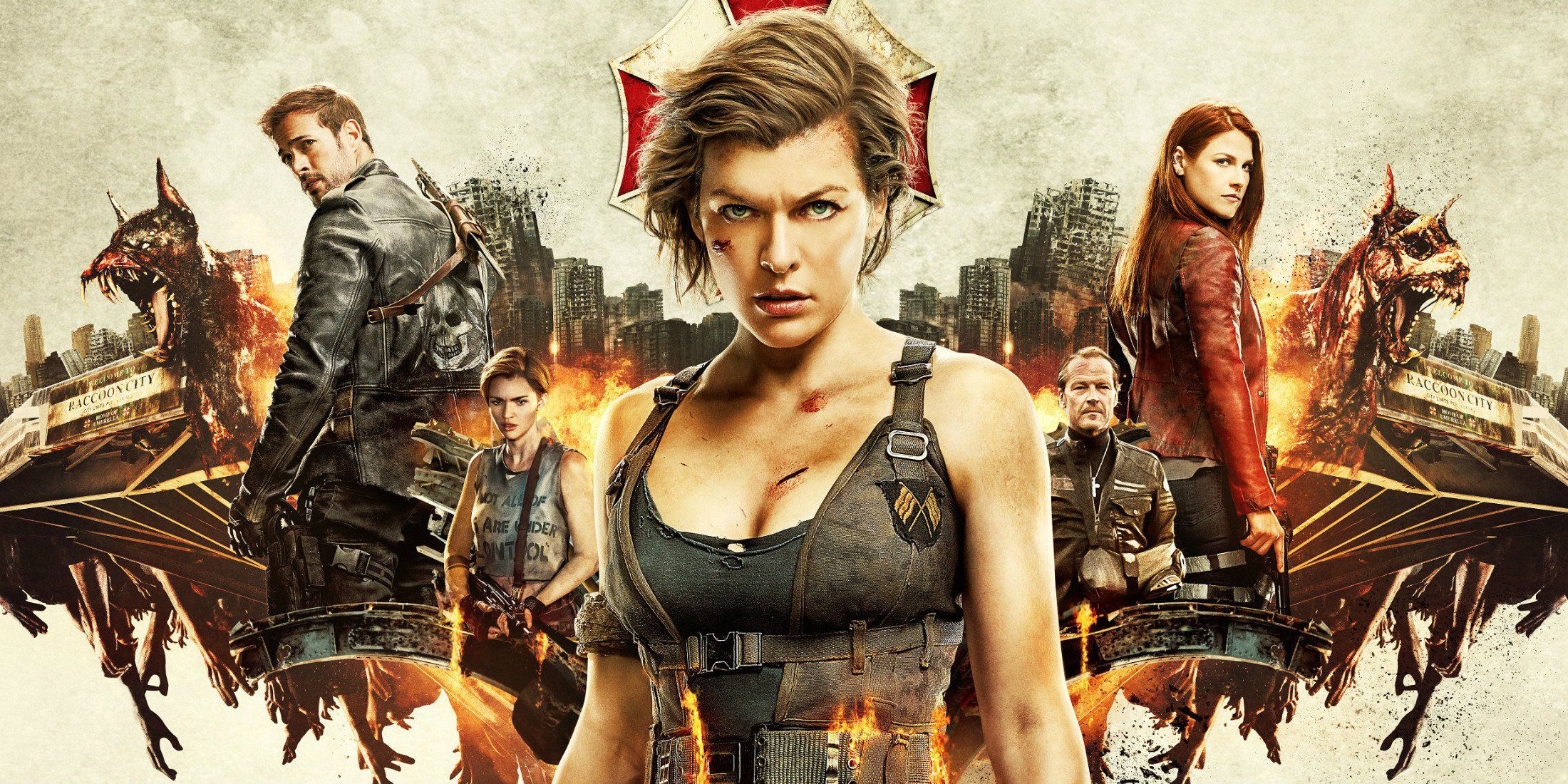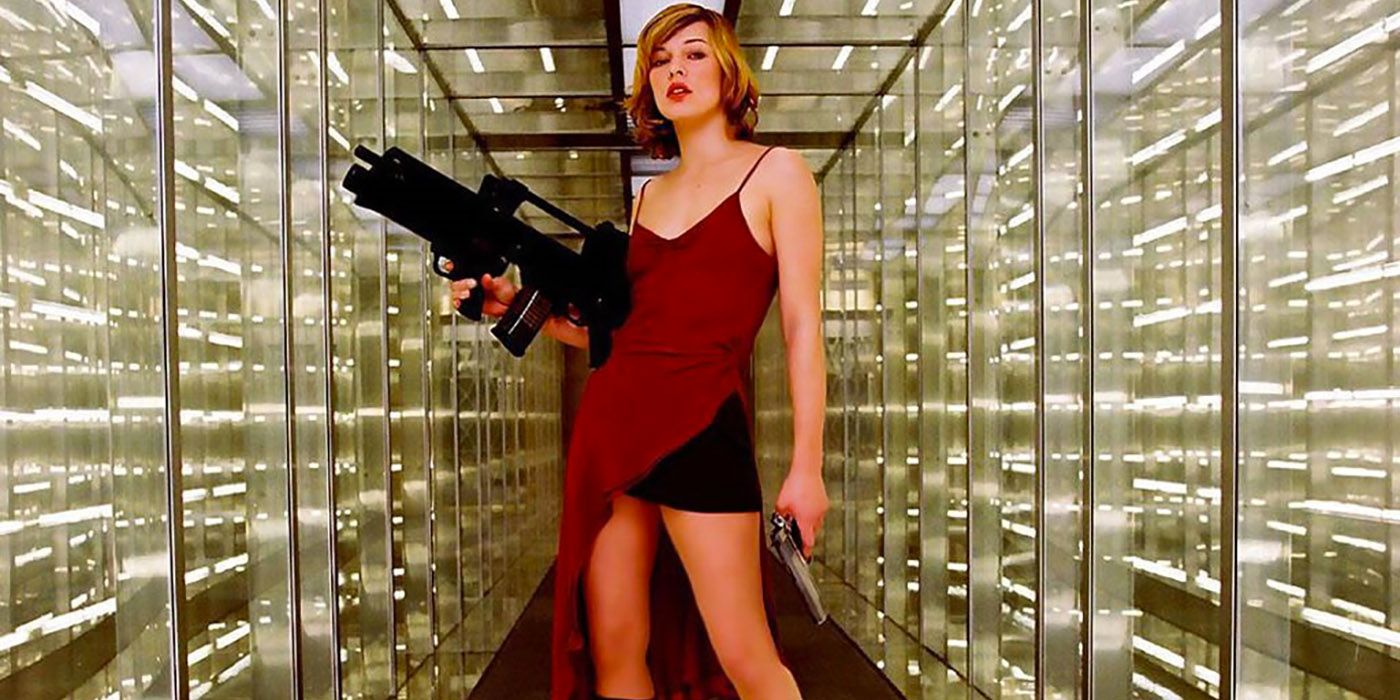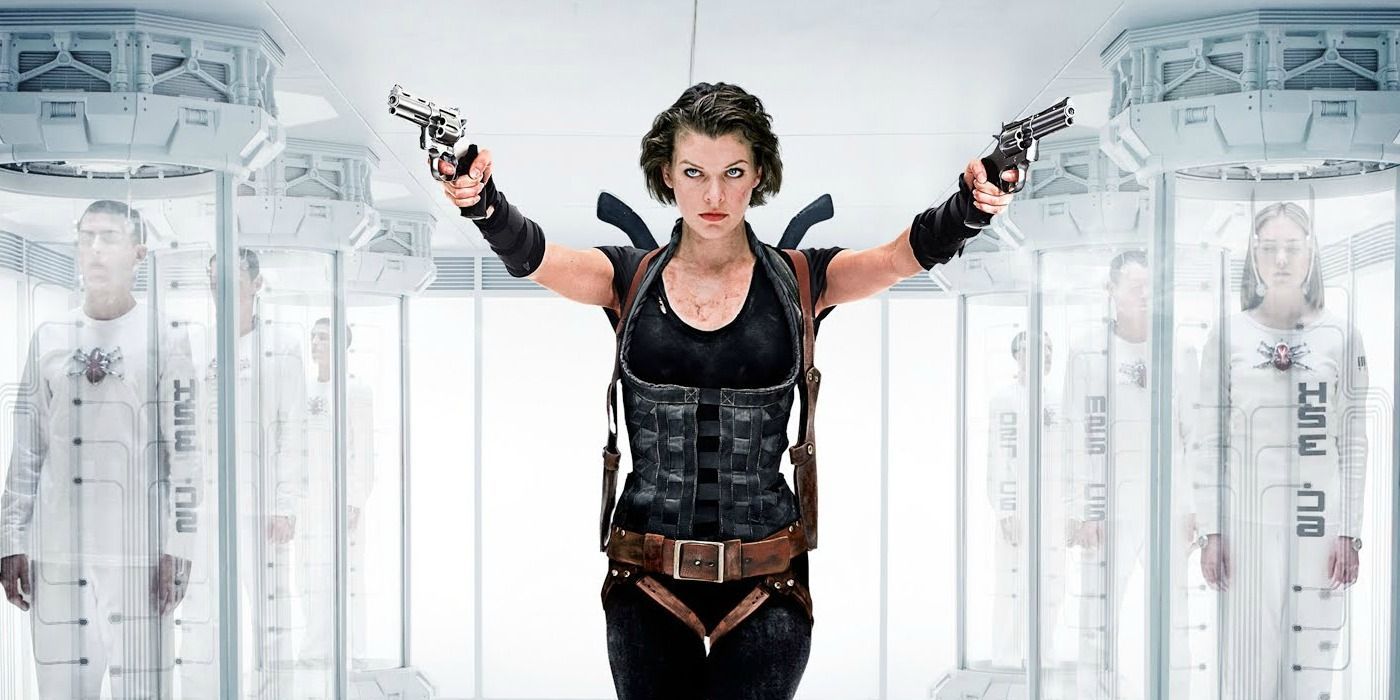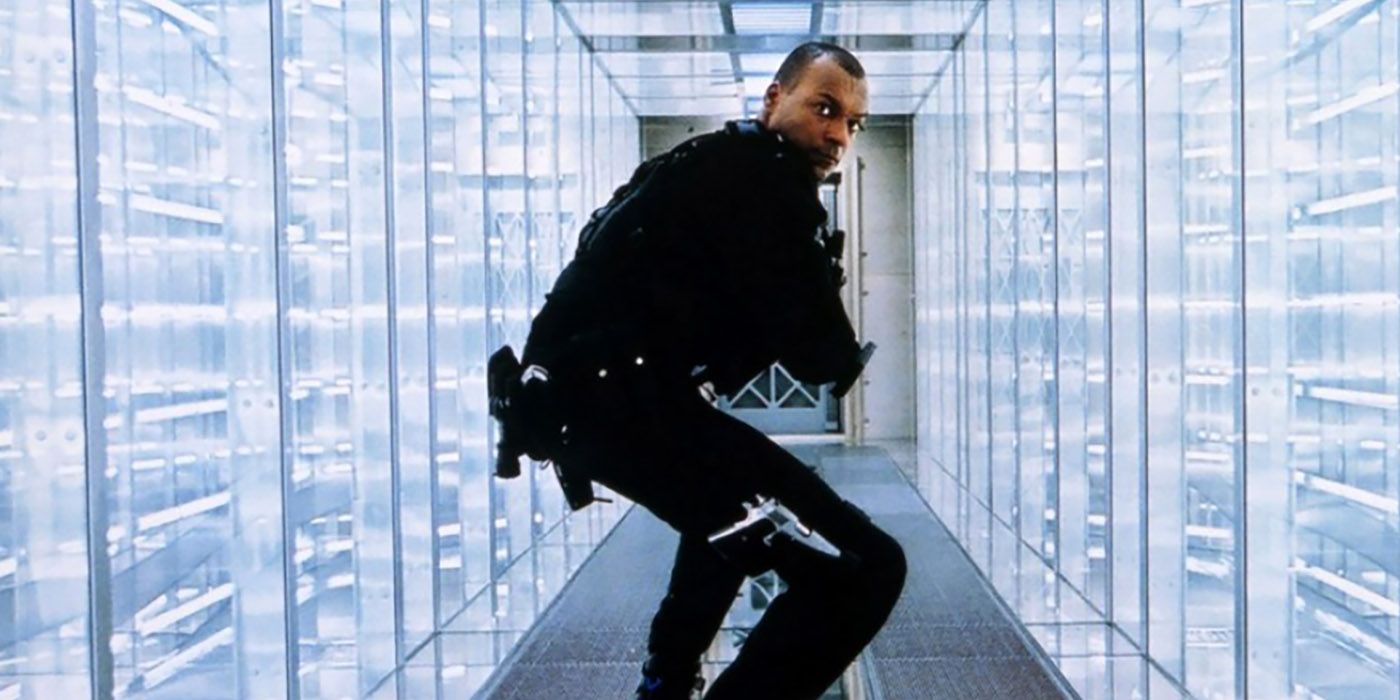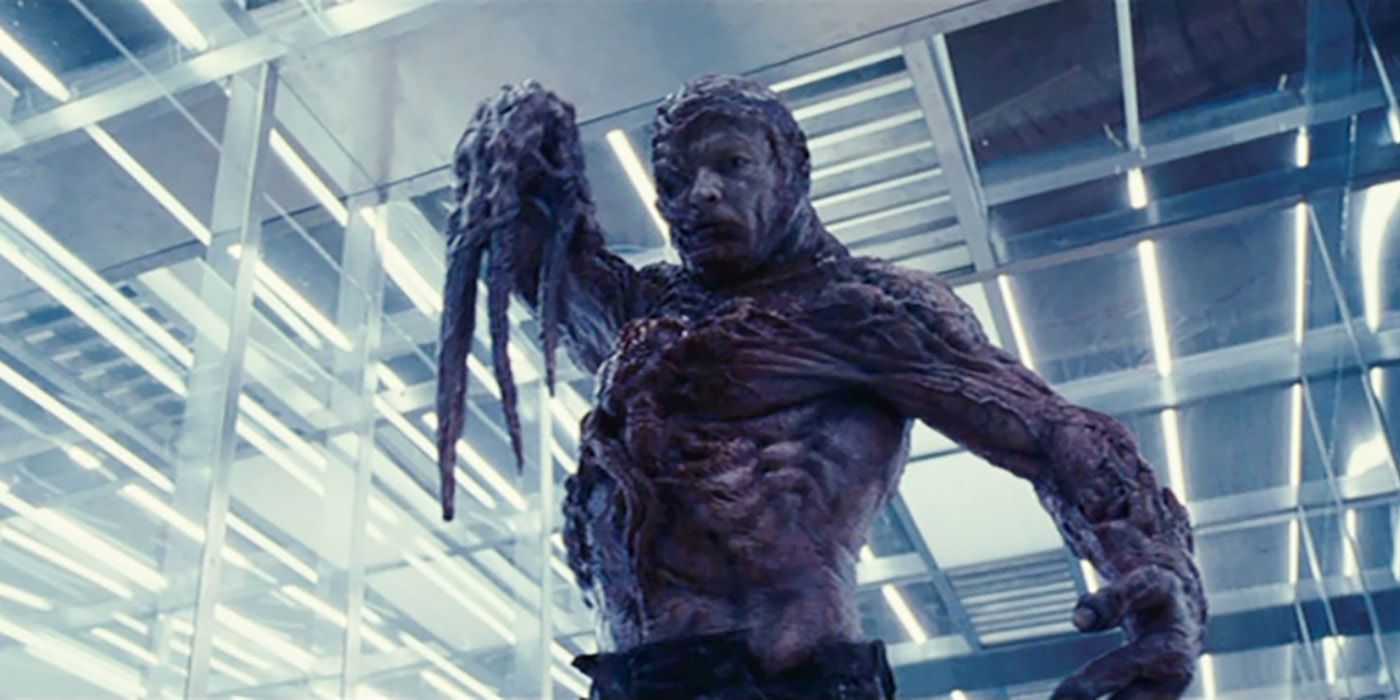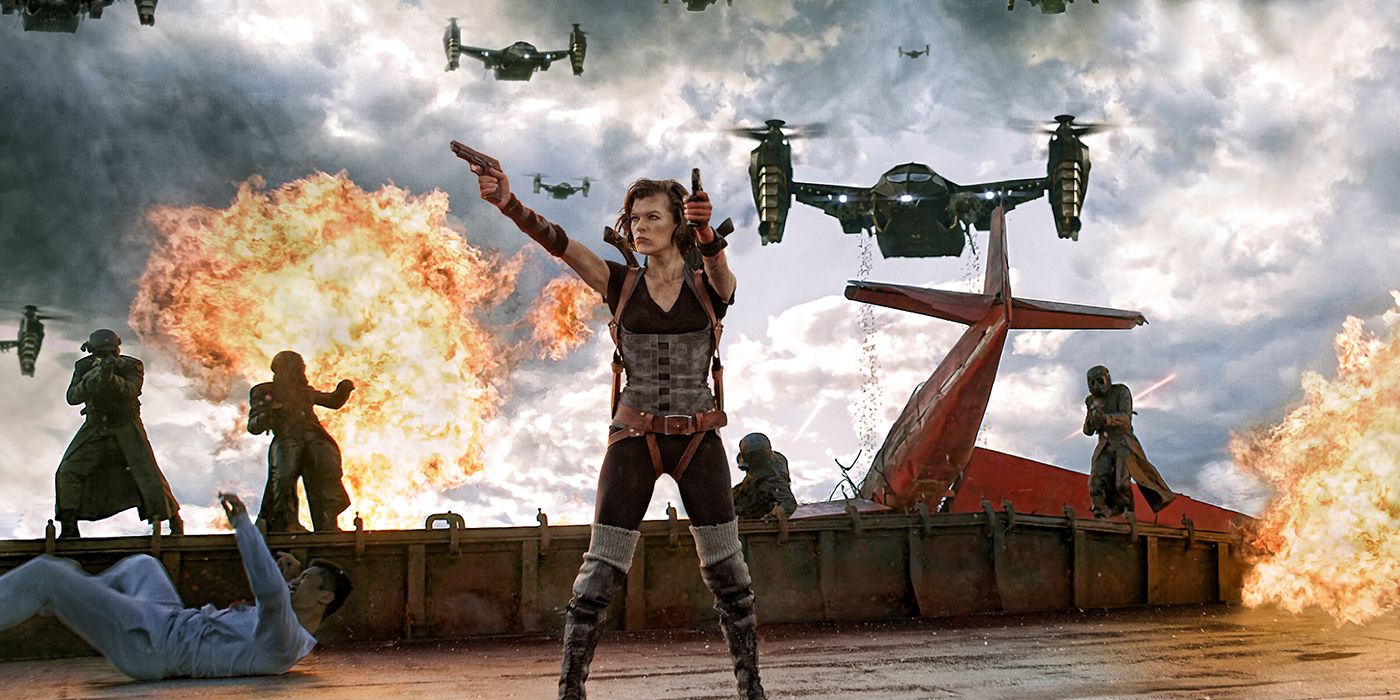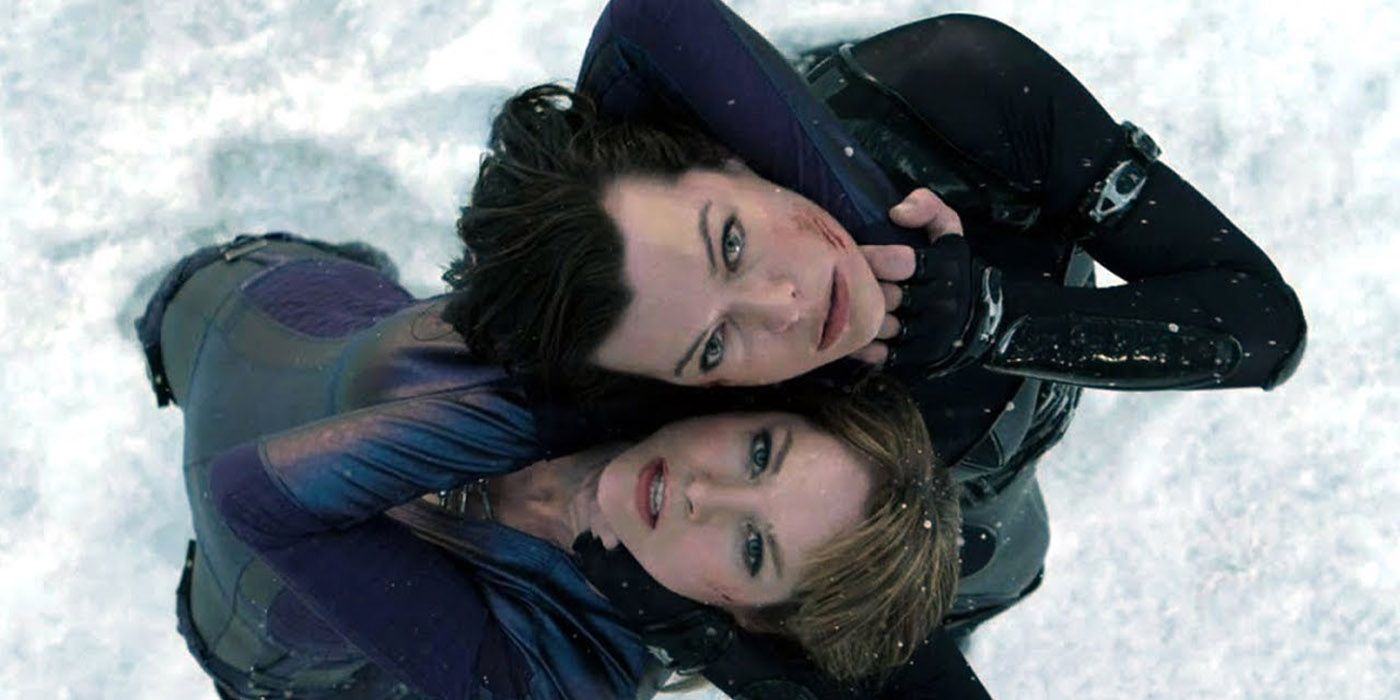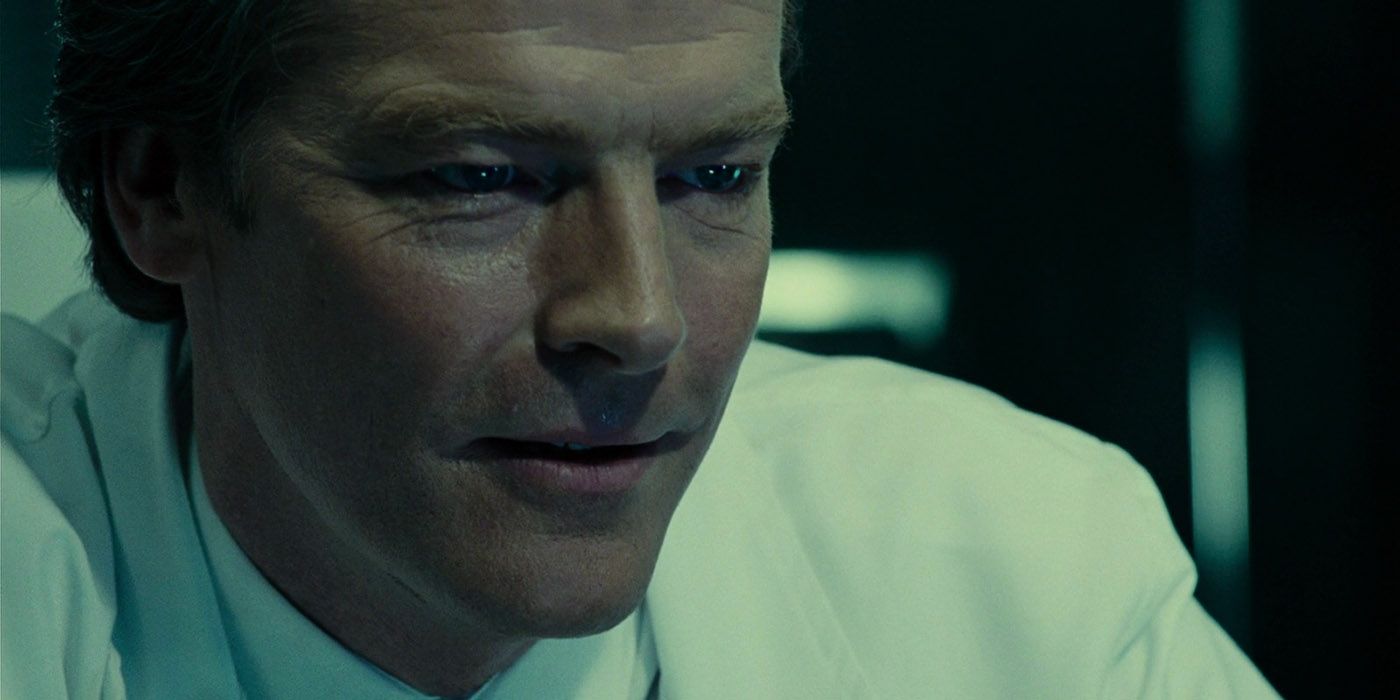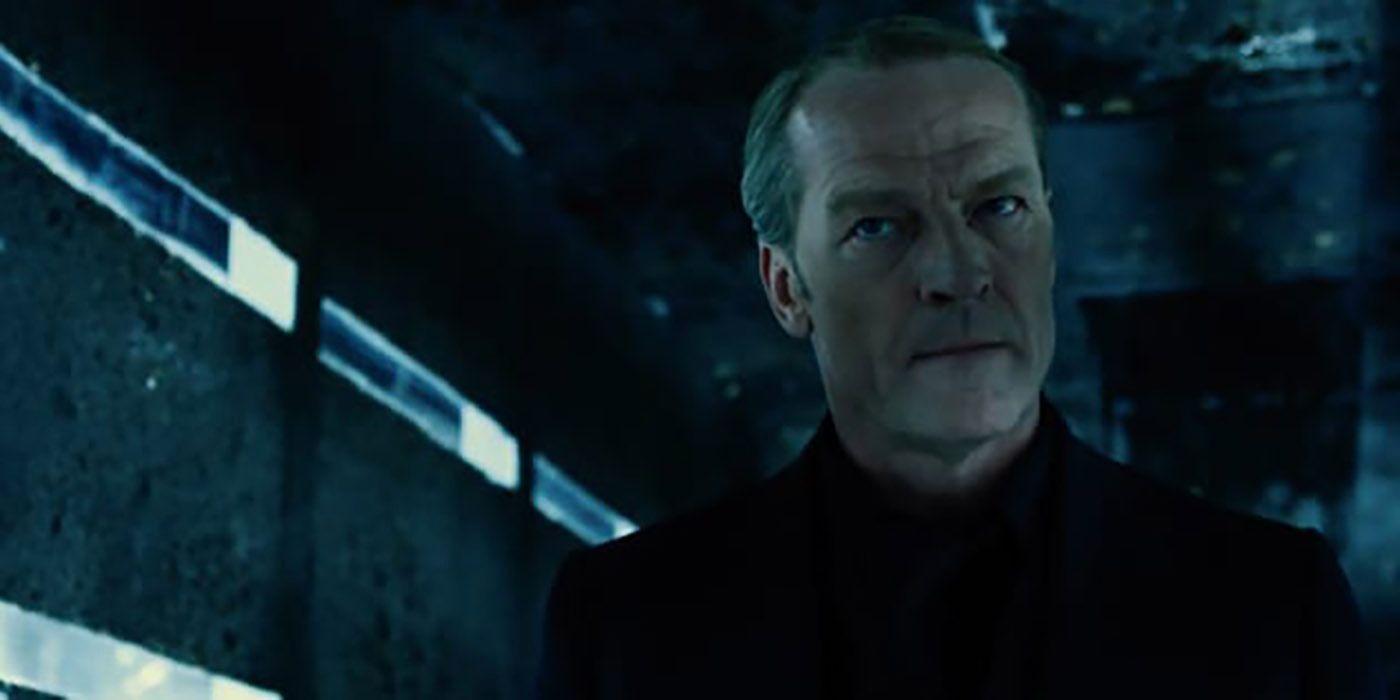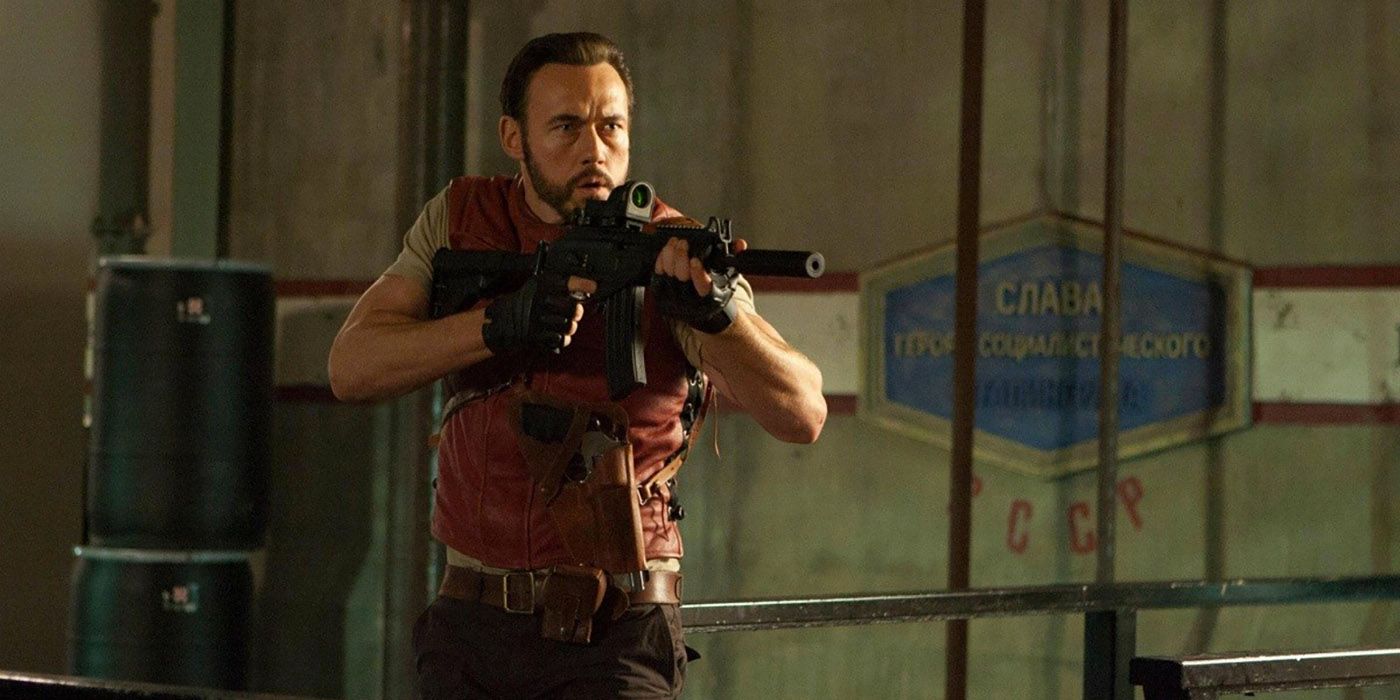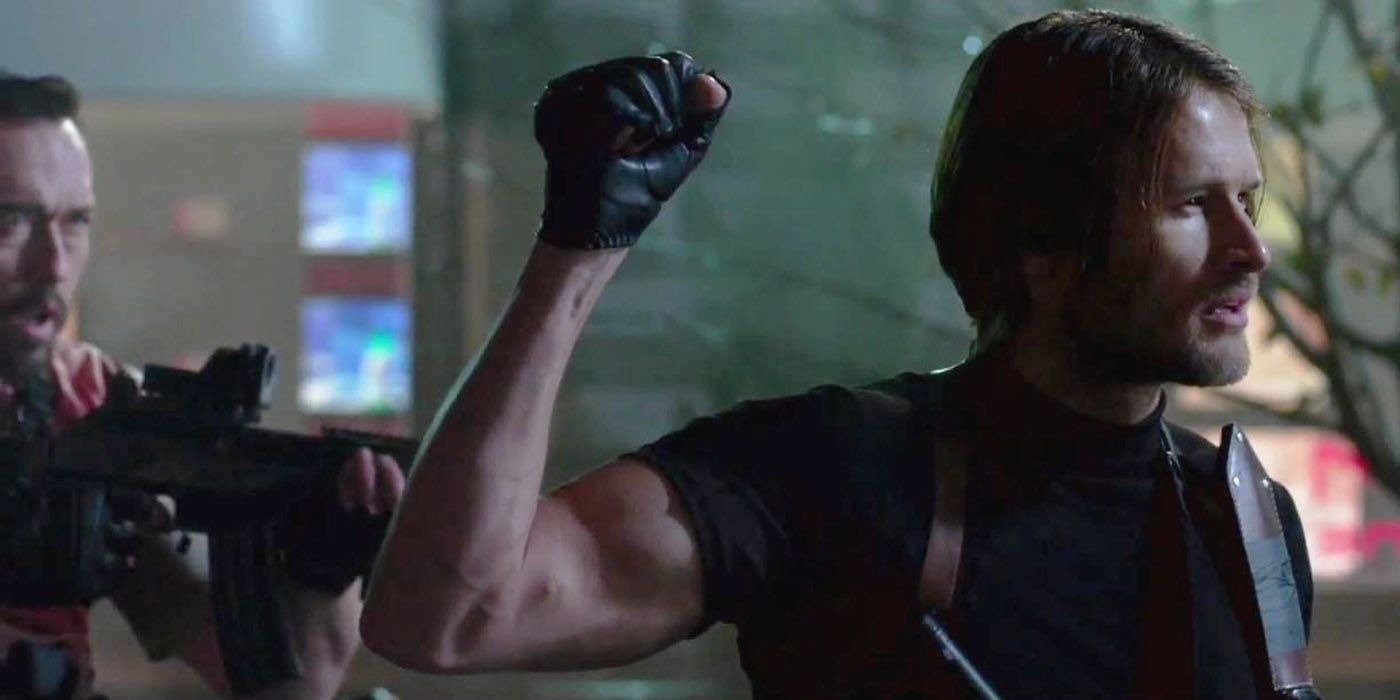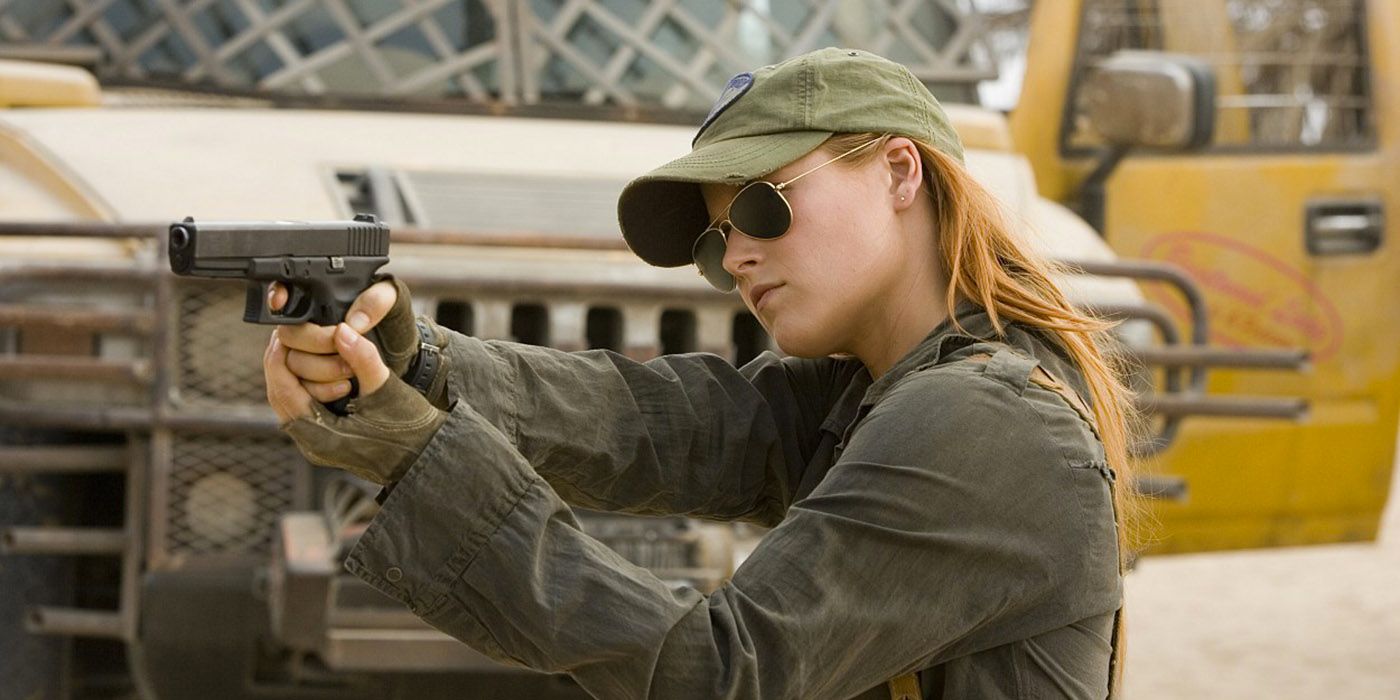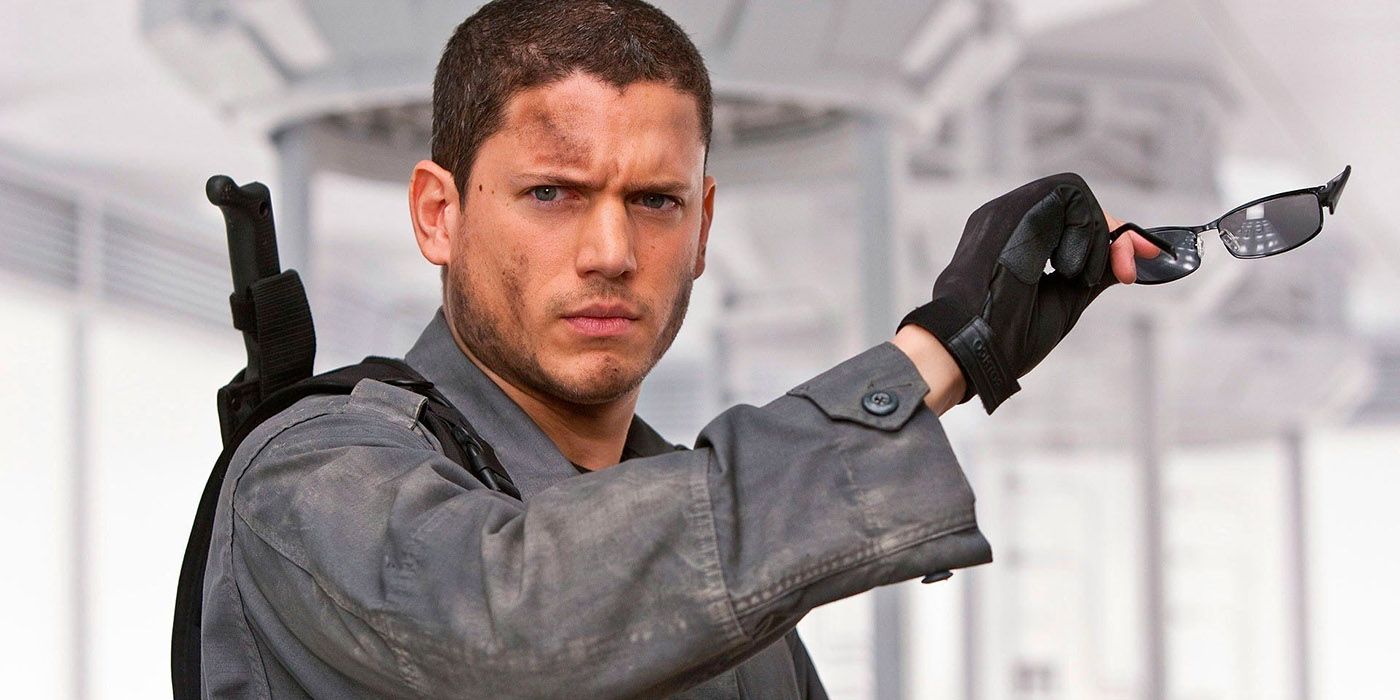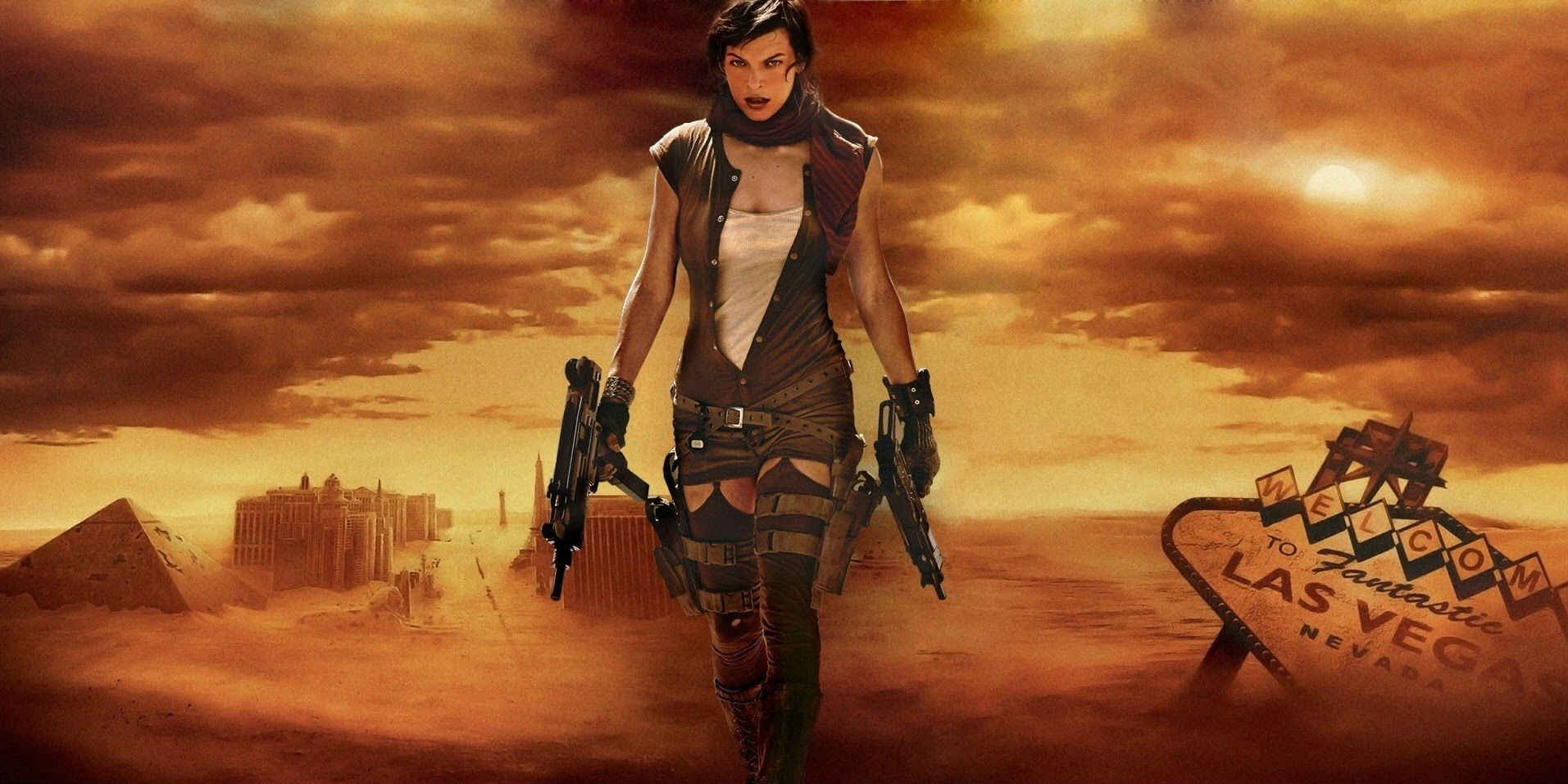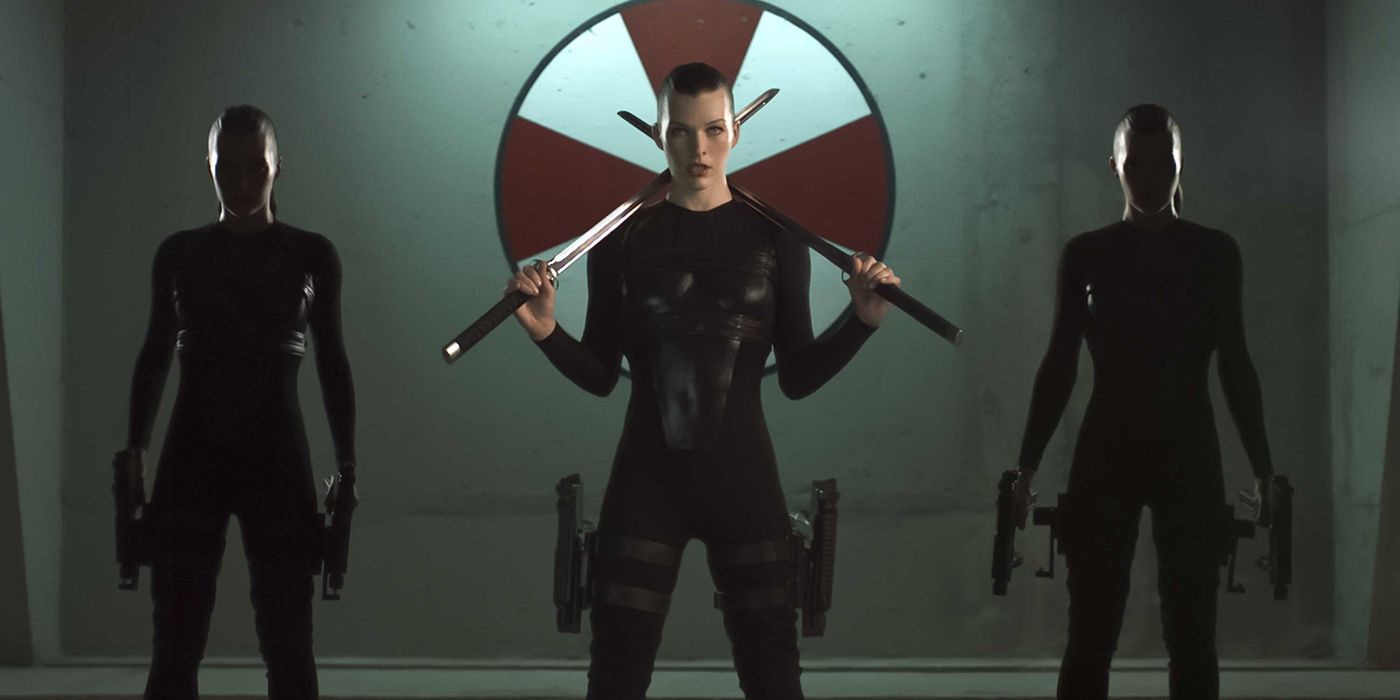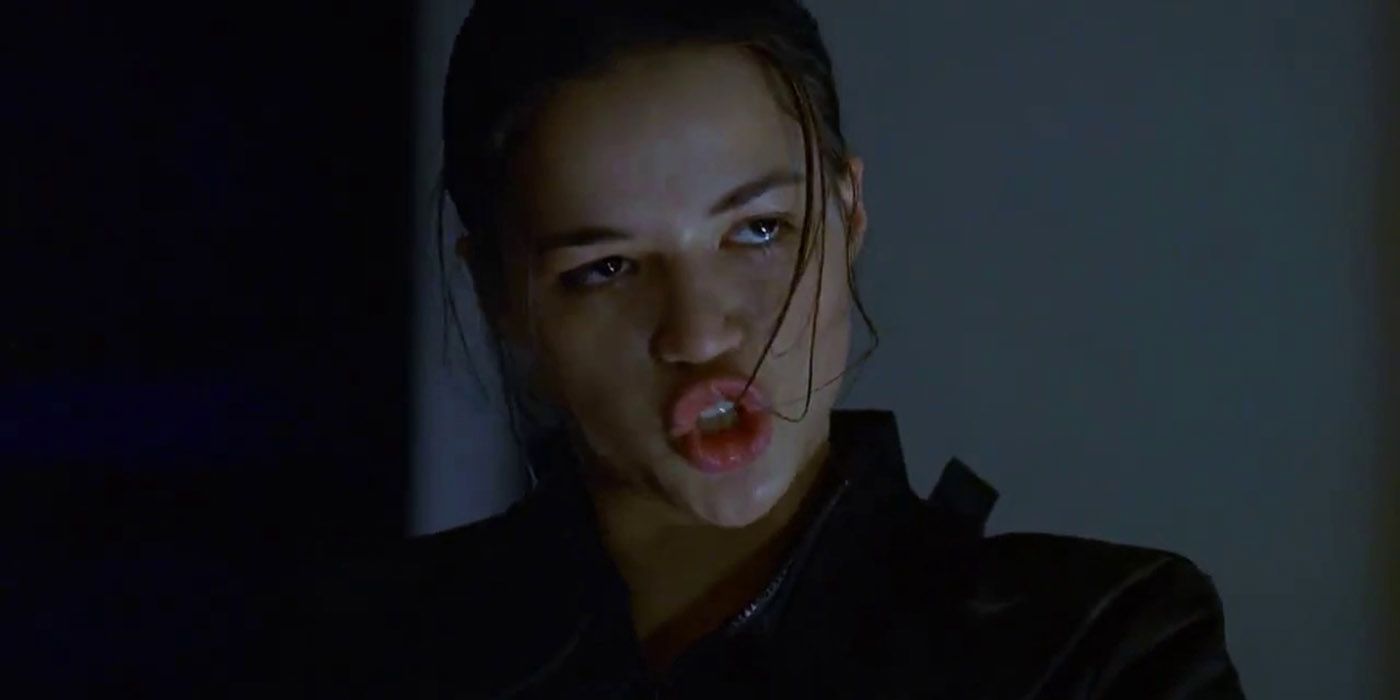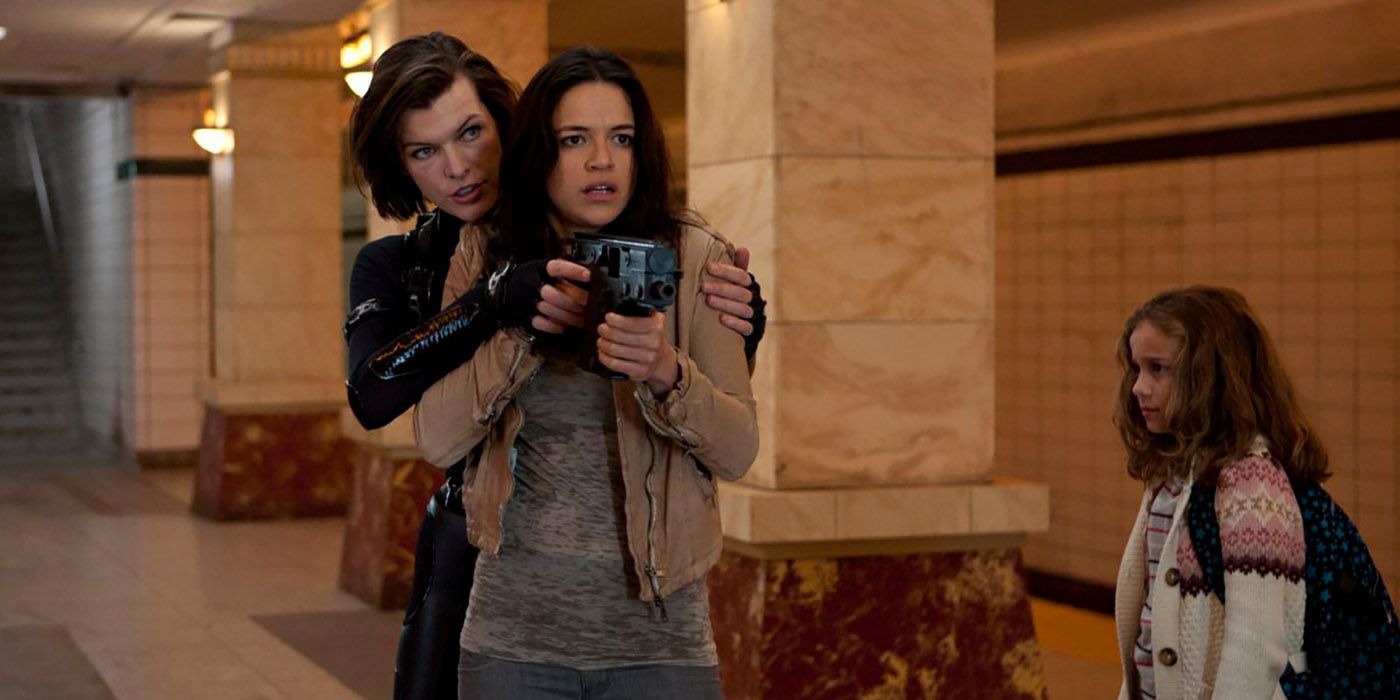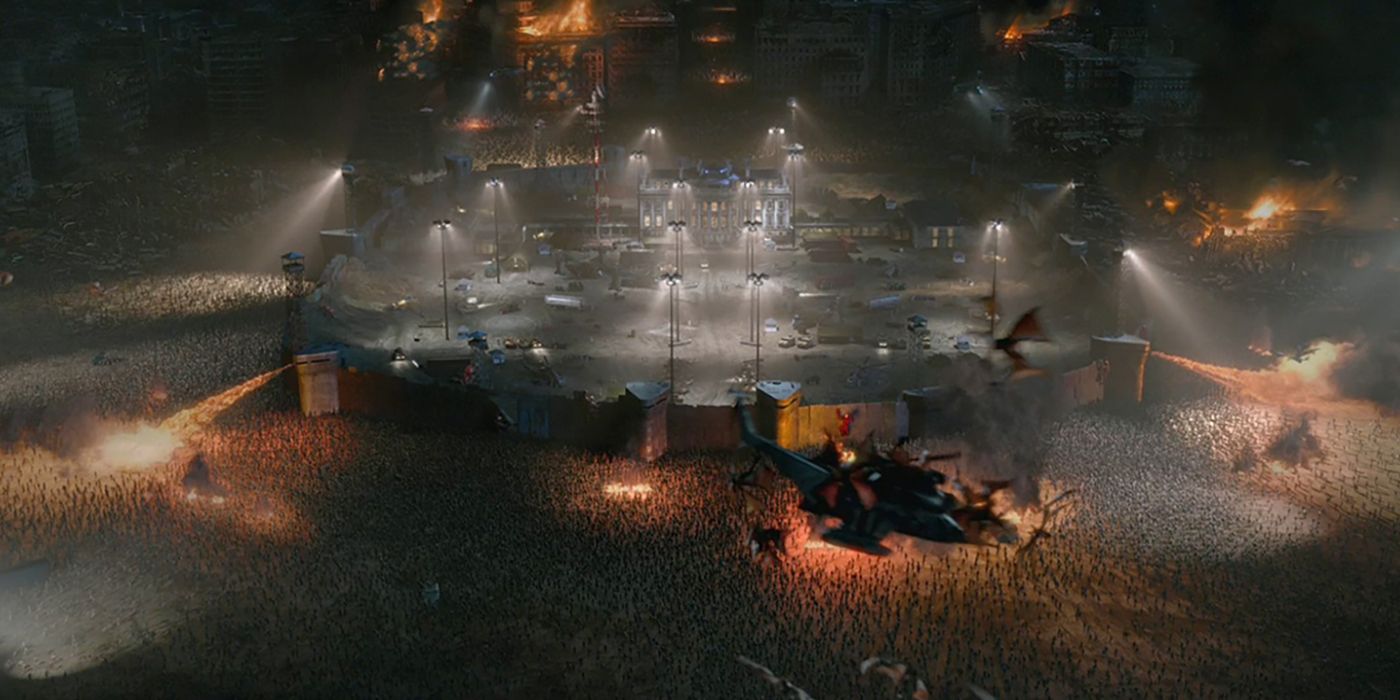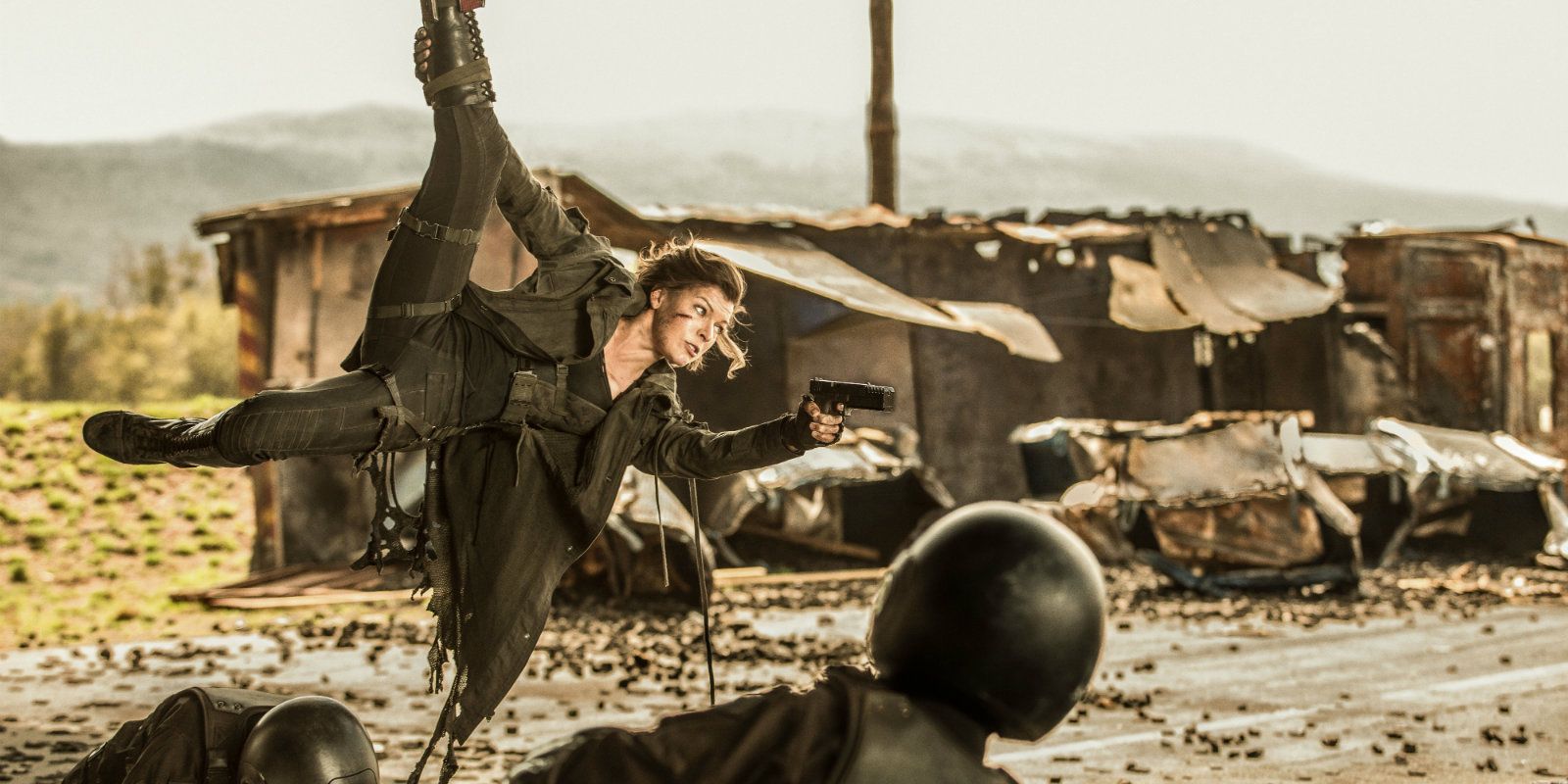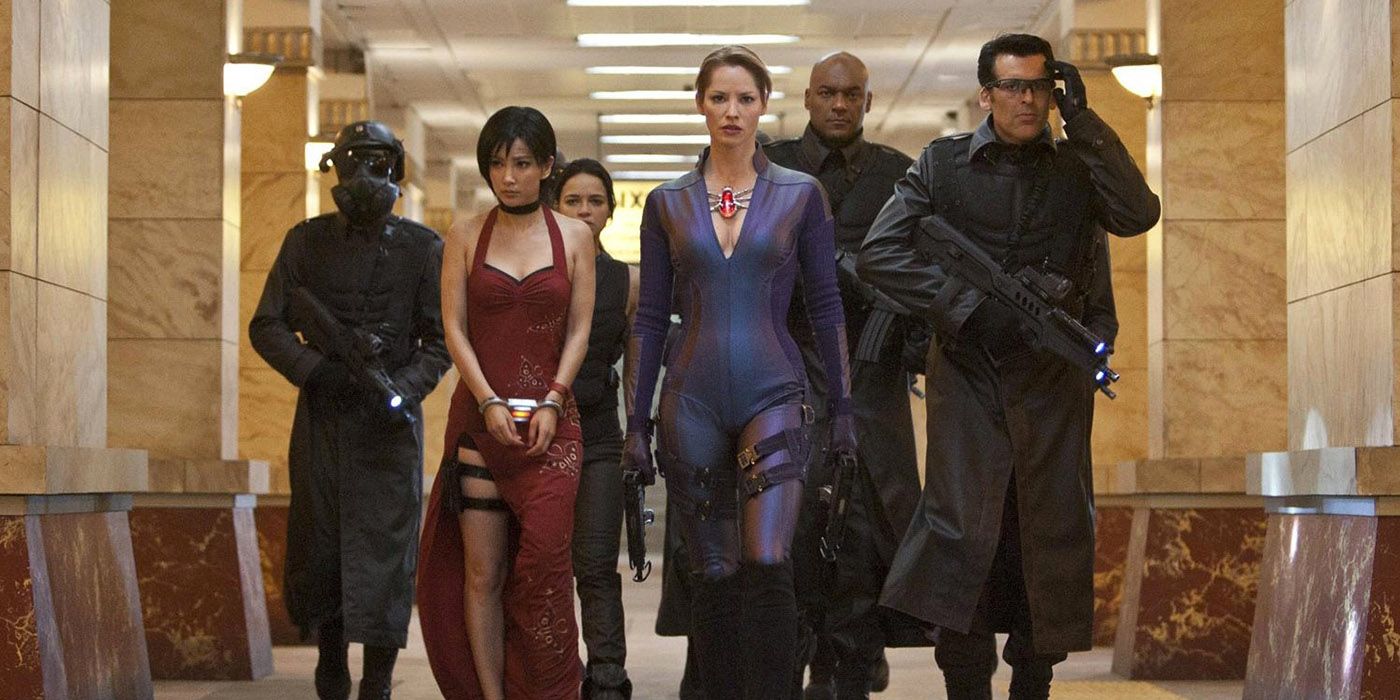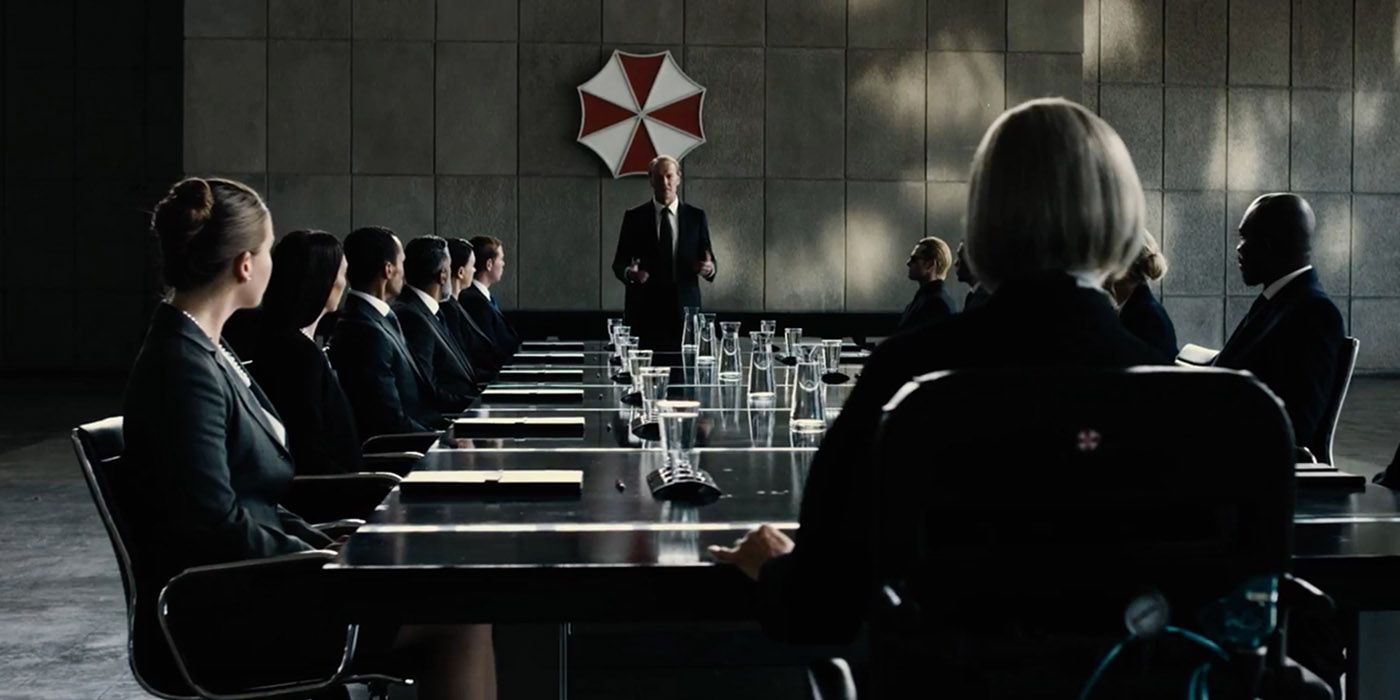Send in the clones - like it or lump it, but Paul W.S. Anderson’s Resident Evil did to the zombie genre what George Romero did in 1968 with Night of the Living Dead. Thanks to fast-paced gut-spilling and a likable cast of hammy rogues, the first Resident Evil in 2002 paved the way for the next 15 years of the most successful game-to-film franchise ever. Clocking in an impressive $1 billion worldwide and making Milla Jovovich’s Alice one of cinema’s greatest action heroes, where would be without Resident Evil?
Spinning off from 1996’s original Resident Evil game, Anderson brought the Umbrella Corporation to cinemas with a brave new take on the source material, creating his own characters and storyline while still trying to remain faithful to Capcom’s game series. However, critical acclaim was never coming for Resident Evil - lambasted for its lazy scripting, insane WTF moments, and one-dimensional characters, the series remained a defiant black sheep of the zombie genre. So, where did Screen Gems go right with their flagship horror, and where did they go wrong? Here's Everything The Resident Evil Movies Got Right (And Wrong).
20. Right: Creating Alice As A New Character
From international supermodel to the flame-haired heroine in The Fifth Element, Milla Jovovich is more commonly known these days as Resident Evil hero, Alice. She may have only accepted the role because her brother Marco was a fan of the game series, but boy are we glad she did. It would have been all too easy to use one of the established game characters, but Anderson made Alice up as his own creation, meaning that the six films could explore the convoluted origins of Janus Prospero (her real name apparently) without game fans shouting, “We know this.” Her dialogue was thin to the point of transparent, but you can’t imagine a Resident Evil film which didn’t start with the immortal refrain: “my name is Alice.”
There were others who came and went, but Alice was always at the forefront of Anderson’s series - maybe it had something to do with the pair being a couple on and off after meeting on the first film - but it worked. Jovovich was as invested in Alice as the audience was, and her reported training for the Resident Evil films ranged from fight classes to martial arts training. From her humble start in that iconic red dress in 2002’s first film, right the way through to taking down Umbrella in The Final Chapter, we went on quite the journey with the unkillable heroine.
19. Wrong: Relying On Alice To Hold Up The Series
Whereas creating Alice was a master stroke, there is no denying that her inclusion in the films may have come at the cost of the supporting cast. Anderson rightly saved characters like Jill Valentine and Chris Redfield for a later date, allowing the films to establish themselves firs, but some fans got tired of waiting,
The first film quickly established Alice as the lead, and the rest seldom trod away from that formula - we had to wait five films before we even got a sniff of Ada Wong or Leon Kennedy. Love it or hate it, Resident Evil: Apocalypse it had more of a team feel, but from then onwards, it was back to all eyes of Umbrella on Alice.
Looking back on Capcom’s games, the 1996 entry to the Spencer Mansion was a joint affair with Valentine, Redfield, Barry Burton, and Albert Wesker. Sadly, this wasn’t the case over in the films: Valentine didn’t arrive until the sequel, Wesker had a cameo in three and then was recast for the fourth film, Chris was relegated to a single film, and Barry got a minuscule part in the fifth film - played by Kevin Durand.
While Alice got a free pass to all the movies, it became a bit too much of the Alice show, and her run of being undefeated meant that audiences were skeptical that she was ever in any real danger. Clearly, Anderson wanted to carve his own story, but was there some Alice overkill?
18. Right: The First Film's Laser Grid
You have to hand it to 2002’s Resident Evil, it stands the test of time even now. Perhaps it was the cheesy ‘80s dialogue, or the high-adrenaline pacing that meant it never took itself too seriously, but as memorable casts of rogues go, Resident Evil has some pretty solid characters.
As Colin Salmon’s Jame “One” Shade lead his group deep under Racoon City, it was a safe bet that most of them wouldn’t make it out alive, however, Anderson’s first film was certainly imaginative in its method of dispatch - mainly one rather infamous laser grid!
It was heart-pounding stuff as we saw the team practice their best martial arts to avoid the Red Queen’s security system. It was a smorgasbord of gore as four of the commandos were mowed down, and watching the likes of Colin Salmon get diced up into a little pineapple hedgehog was a highlight of the film. The laser grid was simply Resident Evil showing off, but little did we know, this wasn’t the last time there would be a game of laser limbo in the series.
17. Wrong: Using The Laser Grid Wherever Possible
“Wow, what a cool way to kill off the characters, I wonder if anyone else will die like that again?” If the laser grid from the original film seemed like a clever way to up the action, the continued use wherever possible became a crutch in the later films.
The grid next returned in the start of Extinction, where Alice Clone #86 was tested in a déjà vu of the first film. Here we saw a mock-up of the Red Queen’s chamber, but it was later actually revealed to be beneath the Nevada desert. Once was enough, but the grid returned in the final boss battle against Iain Glen’s mutated Dr. Isaacs. Okay, that’s enough laser grids now - but wait, we have one more!
The original grid returned in The Final Chapter, for yet another showdown with Dr. Isaacs, but this time it was the real deal, not just a clone (convenient retcon there). It may have cost Alice a couple of fingers, but there wasn't really anything new to see here.
Unfortunately, the laser grid served as the final film’s final boss battle. It's understandable that The Final Chapter wanted to return to its roots, but the Hive’s security system became a default answer to “We don’t know what to do now.” Filling in for credible dialogue, the films chucked in a laser grid whenever they needed an wow moment.
16. Right: The Action Sequences
When you look back over the past 15 years of Resident Evil, it is normally remembered for outlandish stunts more than a compelling plot. It overused its 3D technology and the slow-mo may get a little repetitive, but that was just to make sure you could take in all the crazy of tentacle-mouthed boss battles and Alice taking down Japanese zombies using only a bike chain. Most importantly, the action sequences were always unique - Resident Evil is the only film series where you will see a super-powered heroine set fire to a sky full of crows. Even The Final Chapter had highlights of Alice being chased by Kipepeo, or the scene where they light up the Raccoon City survivor compound.
Admittedly, Resident Evil was at its best when it chucked in a CGI explosion to decimate a population: particular highlights include the government nuking Raccoon City for the greater good, and Wesker’s destruction of the Tokyo HQ.
Literally burning money, these movies love to go out with a bang, and every one offered a high-adrenaline finale where someone typically got their head blasted off. It was popcorn storytelling, but that's why we were hooked!
15. Wrong: The Script
For all the action, the script left a lot to be desired. Sure, everyone can laugh at "No, you're just another asshole," but it is hardly Oscar-worthy prose. Even though we spent 15 years with Alice, she was still basically a stranger. The films only scratched the surface of what could’ve been a great character, instead resorting to wordless fight scenes. The games weren’t exactly known for complex scripts, but it seems like the films used that as a lazy excuse for bad puns and one-liners that would make even your dad cringe.
Pretty much anything that Boris Kodjoe’s Luther West said was to make him seem like a suave lothario, and Mike Epps as L.J. was nothing more than a racist stereotype. Action scenes were a dodgy back and forth of hurling insults at each other, meanwhile, Isaacs and Wesker's dialogue made them into the biggest pantomime villains possible. In fact, probably the only great line in the series is “You’re all going to down here.”
The dialogue was mainly used as a way to introduce character,s fleshing out their origins by literally narrating who they were from the game. For example, the introduction of Ada Wong: “Ada Wong. Operative for the Umbrella Corporation, one of Albert Wesker's top agents. I know exactly who and what you are. Now the real question is: Why don't I just cancel your contract right now?”
We aren’t idiots; the film just treated us like we were.
14. Right: Iain Glen As Dr. Isaacs
While the role as Alice's nemesis became a battle between Dr. Alexander Isaacs and Albert Wesker, it was clear who came out on top in the films. After serving as the main antagonist in Resident Evil: Extinction, it was a big shock when the (apparently) deceased doc was announced to return for The Final Chapter.
The name Isaacs was a tribute to Jason Isaacs, who some may remember played the narrator and uncredited Dr. William Birkin in the first film. With Isaacs out, Birkin's role in the games was amalgamated into Iain Glen’s role as a high-ranking Umbrella doctor for the next film.
The third film represented the real first villain Alice had faced, other than the undead, and gave a face to Umbrella. Deep beneath Nevada, Isaacs' experiments placed him as the real Frankenstein of the series. Just like Birkin before him in the games, Isaacs transformed himself into a grotesque creature of his own creation and bowed out of Extinction with a full-blown boss battle. Glen’s charismatic Isaacs was the perfect intelligent foe that the series had needed, and unlike other sci-fi baddies, he stood out from the crowd.
13. Wrong: Isaacs' Role in "The Final Chapter"
Whatever good was done by his part in Extinction, the Isaacs who returned for The Final Chapter was a shadow of his former self. Back as a religious nut, confined to a tank, the “real” Isaacs revealed that Alice had defeated his clone out in the desert. Why anyone needed this reveal is unclear, but perhaps Anderson just wanted to up the Game of Thrones fan factor. Where Isaacs had been seen as subservient to Chairman Wesker, he was now back to lead Umbrella’s final stand in a convoluted origin flashback.
If Glen was melodramatic in Extinction, The Final Chapter Isaacs had more ham than a butcher. It could've been that they were running low on cast, but we then met the real “real” Isaacs who had been stored in a cryo-sleep under the Hive. It was shown that Isaacs had actually been influential in the start of the T-Virus outbreak, which just seemed like a last-minute addition to move the plot along. Had Isaacs always been part of the story’s origin then it might have worked, but it seemed out of place in the final film and an unnecessary inclusion of a character we had long said goodbye to!
12. Right: Introducing Characters From The Games
Alice was never going to be enough and, with the return of Jill Valentine, the fifth film seemed like the perfect opportunity to bring in more of the Resident Evil mythos. We finally got to meet up with some of the series' best-loved characters and, although it was maligned, Retribution tried its best to be as faithful to the games as possible. It was a triple whammy as Ada Wong, Leon Kennedy, and Barry Burton all joined the fray.
Burton didn’t exactly do a lot, but his inclusion was at least a nod for those eager gamers who wanted some connection to the world they knew and loved. As the numbers of allies around Alice began to dwindle, it was always great to see a new face with a familiar history.
The films became a Wikipedia event to see how new additions were supposed to fit into the Capcom lineage. Up until then, Anderson had always kept himself at a distance from the games, but there is only so much Alice anyone could handle. Seeing the audience reception to the likes of Jill and Claire, he was 100% right to bring in others for the march against the end of the world.
11. Wrong: Waiting 5 Films To Introduce The Best Characters
As the films wound to a close with the firework-filled Retribution, the sparks had begun to falter, and introducing series stalwarts earlier on could’ve lead to a whole different end game. Retribution concluded with an implied history with Ada and Leon, akin to their Capcom counterparts, and even had the ambiguous ending where Leon put his move on Ada. However, we never got to explore their relationship further, as both bit the dust before the start of The Final Chapter.
Li Bingbing excelled as Ada Wong, so why did we have to wait for a decade to meet her from the film series' origins? Strangely, Anderson also retconned the actions of the earlier films, as a faux newspaper article for Resident Evil: Apocalypse stated that Jill had been dismissed after the death of her partner Leon.
As for the man himself, Leon's portrayal was okay at best, but he wasn’t given a lot to work with. Johann Urb had clearly been watching reruns of LOST, with his Leon being a dead ringer for Josh Holloway’s Sawyer. Perhaps if Leon or Wentworth Miller’s Chris Redfield had been given more screen time, or an earlier introduction, fans could’ve warmed to them like the female characters - a missed opportunity and a waste of some great characters.
10. Right: Ali Larter As Claire Redfield
As the powerful convoy leader, Claire Redfield remained defiant in the face of danger and become the deuteragonist of the films. With more lives than a cat, Claire spent most of her life dodging the Umbrella Corp. Unlike Claire from the games, Ali Larter’s version didn’t have an origin - she was actually one of the few characters who didn’t really need one.
Introduced in the time-jump after the second film, Claire was the back-up heroine in Resident Evil: Extinction. It is hard now to think of anyone else other than Larter in the role, but when the character was originally planned for Apocalypse, she was to be played by Ally McBeal’s Gina Philips, then replaced by Desperate Housewives star Emily Bergl, and eventually shelved until the next film.
Highly intelligent, a leader, and uncompromising in her actions, Claire was arguably a better leader than Jovovich’s Alic. As one of the only cast alumni to return for the sixth film, Larter’s inclusion brought with it the usual Hollywood credentials.
While the absence of Jill and Ada is a bugbear, it seems only fitting that Alice walked out into the final film with Claire by her side. Alongside Jovovich, Larter took most of The Final Chapter’s big battles and action scenes, holding her own next to the franchise’s leading lady, and being the most faithful video game character adaptation.
9. Wrong: Wentworth Miller As Chris Redfield
Oh Mr. Redfield, where did it all go wrong? As possibly the best-known male character from the games, hopes were high when Wentworth Miller was cast as Chris Redfield in Resident Evil: Afterlife. What would he get up to, how would he be different from Michael Scofield, could he possibly go full Redfield and punch a boulder? Sadly, as the spooky guy locked in a cage, the whole mystery behind Chris didn’t pay off, and Miller’s performance was a lackluster Prison Break copycat.
The Redfield name promised an epic brother-sister team-up, but he and Ali Larter shared about as much on-screen chemistry as Edward and Bella.There was plenty of Chris Redfield history to go off, but instead, the series went for a “framed killer” story similar to Billy Coen from Resident Evil Zero.
Understandably Miller wanted to make his own mark on the role, but did he? Something surely could’ve been worked out to have Redfield appear in more than just one film, but the general excuse was that Miller’s role in Legends of Tomorrow scuppered those plans to a one-picture deal.
Perhaps most annoying of all, where everyone else was considered deceased as of the opening of The Final Chapter, Anderson stuck a big fat question mark over what happened to one of the series’ least interesting characters - poor show!
8. Right: Alice And Her Powers
Another way that Resident Evil elevated itself from the rest of the zombie genre was by making Alice more than just your standard final girl. In an almost supernatural way, the second film introduced the Alice would evolve into something much bigger. Just as Alien: Resurrection did with Sigourney Weaver’s Ripley, Umbrella made Alice into their very own portable weapon. Set up at the end of Apocalypse, Dr. Isaacs' immortal words “Activate Project Alice” changed the series forever.
When we joined Alice after the time jump for Extinction, she was on the run across the desert, tracked by Umbrella, but now a super strong fighting machine, similar to Ghost in the Shell. In what other movie franchise can you see the lead character set alight a sky full of crows?
The original Project Alice became the dogged pursuit of Isaacs and Wesker, hoping to create their own army of Milla Jovovichs. It was a bit of a cheat. Super Alice was literally unstoppable, but she was most interesting when the little Umbrella symbol was flashing in her eyes.
7. Wrong: WTF Happened To Alice's Powers?
For those who liked the ass-kicking Project Alice and her souped-up new look, it was for the best not to get too attached. When the horde of Alice clones attacked the Tokyo HQ in the fourth film’s stellar opening, real Alice had stowed away on Wesker’s ship. Injected with an anti-virus and having her powers stripped, a depowered Alice was forced to resort to brains and not brawn to take down Wesker.
For the next two films we were reduced to watching a “normal” Alice suffer broken bones and a right good walloping, but still somehow retain her acrobatic skills and marksmanship. Apart from burning up bird sanctuaries, there was little difference to Alice with or without her powers.
However, perhaps the most convoluted plot came at the end of Retribution. As Alice once again finds Wesker (this time sitting pretty in the White House), he injects her to give back her powers, citing that he needed her for the final stand. Picking up in The Final Chapter, it apparently turned out that it was all a trap set by Wesker, therefore retconning the entire scene and making everything (and her powers) redundant. With or without Alice’s powers, Anderson should've picked an idea and stuck with it!
6. Right: Michelle Rodriguez In The First Film
If you ever need a tough-as-nails actress, chances are you can call on Michelle Rodriguez. The fiery 38-year-old made her breakout in 2000’s Girlfight, before starring as Letty Ortiz in 2001’s The Fast and the Furious. By the time she debuted as doomed mercenary Rain Ocampo in Anderson’s first Resident Evil, she was already an established actress with the Hollywood credentials to bring “Oh, it’s her from [blank].”
She may have been a great marksman full of snappy one-liners, but she was a subpar escapee. Rain was bitten multiple times, and knowing how zombie films work, surely she wouldn’t last long. Outside her tough exterior, Rain also had to put down her BFF J.D. when he came to attack the group, but no worries - Rain also bonded with Jovovich’s Alice, and it looked like the two would form a zombie-slaying dream team.
Sadly, Rain eventually succumbed to her bites in a twist of bitter irony, dying just moments before her escape. Rodriguez was undeniably and awesome, and she and Jovovich had the makings of a great duo to take on the rest of the franchise, but wait... she wasn’t done just yet.
5. Wrong: Michelle Rodriguez In "Retribution"
Hooray, Rodriguez is back! Oh wait, not hooray at all. By the time the fifth film came around in 2012, Rodriguez’s stock in Hollywood had suffered thanks to a series of personal problems. With a brief stint on LOST, and another Fast and Furious film under her belt, Rodriguez was the master of resurrection. Just as the Fast films brought Letty back to life, so did Umbrella, making Rain one of their basic model clones. Sure, we got her final battle and the scene of “Bad Rain” being dragged to her watery grave by the Los Plagas Undead, but the highlights ended there.
What need there was to bring Rodriguez back in Retribution? Clearly, the fifth film wanted to tie back to the franchise’s first, but was throwing all of the alumni at it the best way to do that? Bad Rain wasn’t insufferable, but the whiny soccer mom "Good Rain" was clearly out of Rodriguez’s comfort zone. Anderson may have wanted some more screen time of Alice with friends to make her seem more human, but Rain’s inclusion just to upped the body count.
4. Right: The Final Scene In "Retribution"
As previously stated, the fifth film was something of a grand affair. It tried to cram in as many new additions and old faces as possible before the Red Queen massacred everyone - some bits worked, some bits didn’t.
As Alice and her survivors escaped the Umbrella Prime base, everyone was back together. Bad Rain was underwater, Jill was no longer supporting that glowing jewelry, and Leon and Ada were making goo-goo eyes across the chopper. The final scene of Retribution has to be one of the franchise’s greatest, as all our survivors are taken to an apocalyptic Washington D.C. to watch the world burn. Ithad CGI galore, big explosions, and everything you could possibly want from a Resident Evil film - it was almost poetic.
As our heroes gather on the roof, the camera pans out to give a look at the true carnage that Umbrella has caused across the globe. Gunships taking on the flying Kipepeo dragons, millions of undead at the gates, and Wesker’s remaining humans taking on the T-Virus.
It really looked like a last stand and set up a bloodthirsty finale. If they had stopped Resident Evil right there, many would’ve been happy. There could even have been an extended runtime for Retribution to tack on a five-minute final battle, but oh no, there had to be one more film.
3. Wrong: The Time Jump From "The Final Chapter"
When the cast list for The Final Chapter was released, die-hard fans of the series were right to be puzzled and worried. Where was Sienna Guillory, where was Li Bingbing, and where the hell was Wentworth Miller? Given that the characters we were left with alive in the world at the end of Retribution, surely we could expect to see Jill and Alice hand in hand to take on the mutants of the wasteland, or Leon and Ada to kiss and make up, or Chris Redfield to finally make it off Arcadia?
Alas, 15 years of Resident Evil build-up was thrown away in one dusty cutaway. As Alice emerged from a bunker at the start of the film, it was clear she was alone and that something terrible had happened.
As the most successful game-to-film franchise out there, it wasn’t like there wasn’t the money to create the D.C. battle, so its absence is baffling. It was a similar story to disregarding the end of Apocalypse, which left audiences left scratching their heads at how anyone got to their current location. Yeah, we do eventually meet up with Claire Redfield, but the lives of so many series regulars are explained away in just a sentence of “Everyone’s dead.” It felt like a middle finger to fans and immediately got The Final Chapter off on the wrong foot.
2. Right: The First Five Films
Look, Resident Evil was never going to win any awards as a pioneering piece of cinema, but it knew what it was. The first five films frequently trod into the realms of ridiculous and we knew what we were getting for our money: Alice getting out of a sticky situation with the help of some characters from Capcom’s games, often featuring laser grid or a clone to help, and some shocking final twist.
Let’s not forget the cast either; Jovovich excelled as an unlikely lead, backed up by the likes of Eric Mabius, Iain Glen, Shawn Roberts, Sienna Guillory and Ali Larter - the supporting actors were as great as the lead warrior. As light popcorn horror and action stupidity, Resident Evil had the market cornered.
As the films grew in number, they also grew in ambition. Anderson took the basic template of the games and ran with what had worked. The first few films were so influential that parts like the laser grid and over into the game series as well, and Jovovich said she aspired to have Alice appear in the games too (admittedly it hasn't happened yet).
Even if some criticize the likes of Resident Evil 6 for being too cinematic and less like a survival horror game, the games and films worked hand-in-hand. The Rotten Tomatoes scores are never going to be great for Resident Evil, but does anyone really care? With five reasonably good films under Anderson's belt... then came The Final Chapter.
1. Wrong: The Final Chapter
Where to begin? Feeling more like an Underworld film than anything else, Resident Evil: The Final Chapter became lost under its own weight, suffocated by ham-fisted scripting, obvious plot twists, and that annoyingly ambiguous ending. It may be called The Final Chapter, but did Saw, Friday the 13th and A Nightmare on Elm Street teach us nothing? As Alice rode off into the distance, most people are hoping that this really is the end!
The Final Chapter brought back Iain Glen’s Doctor Isaacs (for no reason), included Anderson and Jovovich’s daughter (for no reason), and featured Ruby Rose’s abysmal American accent. The first five films had worked so hard to set the sixth film up as some sort of credible finale, but Anderson threw what fan's wanted out of the window in favor of Milla Jovovich's old lady prosthetics.
The Final Chapter did succeed on some levels, like the introduction of the Umbrella tanks and the survivor compound battle, but everywhere else it, fell to the lowest depths of Umbrella Prime. Wesker was reduced to secondary pantomime villain and the new additions became nameless cannon fodder; it relied too much on repeating tired trope, and the Alice being a clone/Alicia Marcus twist could've been clocked around film two. From its humble but consistent roots, Resident Evil limped out of the Hive with one too many laser grids and unnecessary retcon twists, right into a disappointing finale.
---
Wha are you favorite (and least favorite) parts of the Resident Evil franchise? Let us know in the comments!

